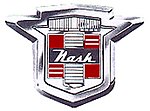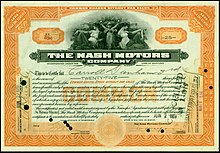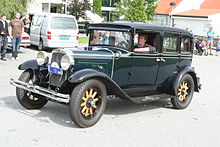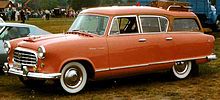
Nash

 |
|
| Industry | Automobile |
|---|---|
| Fate | Merged |
| Successor | Nash-Kelvinator |
| Founded | 1916 |
| Defunct | 1954 |
| Headquarters | Kenosha, Wisconsin, United States |
|
Key people
|
Charles W. Nash, Nils Erik Wahlberg |
| Products | Vehicles |

Nash Motors Company was an American automobile manufacturer based in Kenosha, Wisconsin, in the United States from 1916 to 1937.
From 1937 to 1954, Nash Motors was the automotive division of the Nash-Kelvinator Corporation Nash production continued from 1954 to 1957 after the creation of American Motors CorporationNash pioneered some important innovations; in 1938 they debuted the heating and ventilation system which is still used today, unibody construction in 1941, seat belts in 1950, a US built compact car in 1950, and muscle cars in (1957).
History





Nash Motors was founded in 1916 by former General Motors president Charles W. Nash who acquired the Thomas B. Jeffery Company. Jeffery's best-known automobile was the Rambler whose mass production from a plant in Kenosha, Wisconsin began in 1902.
The 1917 Nash Model 671 was the first vehicle produced to bear the name of the new company's founder. Nash enjoyed decades of success by focusing its efforts to build cars "embodying honest worth ... [at] a price level which held out possibilities of a very wide market."
The four-wheel drive Jeffery Quad truck became an important product for Nash. Approximately 11,500 Quads were built between 1913 and 1919. They served to move material during World War I under severe conditions. The Quad used Meuhl differentials with half-shafts mounted above the load-bearing dead axles to drive the hubs through hub-reduction gearing. In addition, it featured four-wheel steering. The Quad achieved the reputation of being the best four-wheel drive truck produced in the country. The newly formed Nash Motors became the largest producer of four-wheel drives. By 1918, capacity constraints at Nash meant the Paige-Detroit Motor Car Company began to assemble the Nash Quad under license and Nash patents. Nash became the leading producer of military trucks by the end of World War I. After the war ended, surplus Quads were used as heavy work trucks in fields such as construction and logging.
Charles Nash convinced the chief engineer of GM's Oakland Division, Finnish-born Nils Eric Wahlberg, to move to Nash's new company. The first Nash engine introduced in 1917 by Wahlberg had overhead valves. Wahlberg is also credited with helping to design flow-through ventilation that is used today in nearly every motor vehicle. Introduced in 1938, Nash's Weather Eye directed fresh, outside air into the car's fan-boosted, filtered ventilation system, where it was warmed (or cooled), and then removed through rearward placed vents. The process also helped to reduce humidity and equalize the slight pressure differential between the outside and inside of a moving vehicle. Another unique feature of Nash cars was the unequal wheel tracks. The front wheels were set slightly narrower than the rear, thus adding stability and improving cornering. Wahlberg was also an early proponent of wind tunnel testing for vehicles and during World War II worked with Theodore (Ted) Ulrich in the development of Nash's radically styled Airflyte models.
Nash's slogan from the late 1920s and 1930s was "Give the customer more than he has paid for" and the cars lived up to it. Innovations included a straight-eight engine with overhead valves, twin spark plugs, and nine crankshaft bearings in 1930. The 1932 Ambassador Eight had synchromesh transmissions and free wheeling, automatic centralized chassis lubrication, a worm-drive rear end, and its suspension was adjustable inside the car. A long-time proponent of automotive safety, Nash was among the early mid- and low-priced cars to offer four-wheel brakes.
The Nash was a success among consumers that meant for the company "selling for a long time has been 100% a production problem... month after month all the cars that could be produced were sold before they left the factory floor."
Creation of the Ajax
For the 1925 model year, Nash introduced the entry-level marque Ajax. A car of exceptional quality for its price, the Ajax was produced in the newly acquired Mitchell Motor Car Company plant in Racine, Wisconsin. Mitchell was the manufacturer of Mitchell-brand automobiles between 1903 and 1923. Sales of Ajax automobiles, while quite respectable, were disappointing. It was believed that the same car would sell better if it were called a Nash. Thus the Ajax became the "Nash Light Six" in June, 1926 and sales did improve, just as expected. In an unusual move, Nash Motors offered all Ajax owners a kit to "convert" their Ajax into a Nash Light Six. This kit, supplied at no charge, included a set of new hubcaps, radiator badge, and all other parts necessary to change the identity of an Ajax into that of a Nash Light Six. This was done to protect Ajax owners from the inevitable drop in resale value when the Ajax marque was discontinued. In this way Nash Motors showed the high value they placed upon their customers' satisfaction and well-being. Most Ajax owners took advantage of this move, and "unconverted" Ajax cars are quite rare today.
Acquisition of LaFayette
LaFayette Motors was the producer of a large, powerful, expensive luxury car. The company started in Indianapolis, Indiana, in 1920, and later moved to Milwaukee, Wisconsin. The principal stockholder in LaFayette Motors was Nash Motors Company. Other major stockholders were Charles W. Nash and friends and business associates. The high quality, high priced LaFayette cars did not sell well.
In 1924, Nash absorbed LaFayette Motors and converted its plant to produce Ajax automobiles. The LaFayette name was reintroduced in 1934 as a lower priced companion to Nash. LaFayette ceased to be an independent marque with the introduction of the 1937 models. From 1937 through 1940, the Nash LaFayette was the lowest priced Nash, and was replaced by the new unibody Nash 600 for the 1941 model year.
Era of George Mason and Nash Kelvinator


Before retiring, Charlie Nash chose Kelvinator Corporation head George W. Mason to succeed him. Mason accepted, but placed one condition on the job: Nash would acquire controlling interest in Kelvinator, which at the time was the leading manufacturer of high-end refrigerators and kitchen appliances in the United States. The resulting company, as of January 4, 1937, was known as the Nash-Kelvinator Corporation. Nash as a brand name continued to represent automobiles for Nash-Kelvinator. This was the largest merger of companies not in the same industry up until that time.
In 1938, Nash introduced an optional conditioned air heating/ventilating system, an outcome of the expertise shared between Kelvinator and Nash. This was the first hot-water car heater to draw fresh air from outside the car, and is the basis of all modern car heaters in use today. Also in 1938, Nash, along with other car manufacturers Studebaker and Graham, offered vacuum-controlled shifting, an early approach at removing the gearshift from the front floorboards. Automobiles equipped with the Automatic Vacuum Shift (supplied by the Evans Products Company) had a small gear selector lever mounted on the dashboard, immediately below the radio controls.
In 1936, Nash introduced the "Bed-In-A-Car" feature, which allowed the car's interior to be converted into a sleeping compartment. The rear seat back hinged up, allowing the rear seat cushion to be propped up into a level position. This also created an opening between the passenger compartment and the trunk. Two adults could sleep in the car, with their legs and feet in the trunk, and their heads and shoulders on the rear seat cushions. In 1949 this arrangement was modified so that fully reclining front seat backs created a sleeping area entirely within the passenger compartment. In 1950 these reclining seat backs were given the ability to lock into several intermediate positions. Nash soon called these new seat backs "Airliner Reclining Seats".
In 1939, Nash added a thermostat to its "Conditioned Air System", and thus the famous Nash Weather Eye heater was born. The 1939 and 1940 Nash streamlined cars were designed by George Walker and Associates and freelance body stylist Don Mortrude. They were available in three series - LaFayette, Ambassador Six and Ambassador Eight. For the 1940 model cars Nash introduced independent coil spring front suspension and sealed beam headlights.
The 1941, Nash 600 was the first mass-produced unibody construction automobile made in the United States. Its lighter weight compared to body-on-frame automobiles and lower air drag helped it to achieve excellent fuel economy for its day. The "600" model designation is said to have been derived from overdrive-equipped examples of this car's ability to travel 600 miles (966 km) on a 20-US-gallon (75.7 l; 16.7 imp gal) tank of gasoline. In other words, it would achieve 30 miles per US gallon (7.8 L/100 km; 36 mpg‑imp). The 600 models used an unusual steering/front suspension system with extremely long king pins. Inadequate lubrication became a problem for these systems, commonly resulting in premature failures. The design of the cars was improved by new front ends, upholstery, and chrome trim from 1942 to 1948. The larger Ambassador models shared the same bodies with the 600 but placed this unibody structure on top of a conventional frame, resulting in an extremely strong car.
Post-World War II passenger car production resumed on October 27, 1945 with an Ambassador sedan first off the assembly line. There were few changes from 1942 models, most noticeable were longer and slimmer upper grille bars and a projecting center section on the lower grille. The 600 models got a new, more conventional front suspension & steering system. The inline 8-cylinder Ambassador model did not return in 1946. The large Ambassador engine thus was the seven main bearing, overhead-valve, 234-cubic-inch (3.83 L), six-cylinder developing 112 brake horsepower. For the 1946 model year, Nash introduced the Suburban model that used wood framing and panels on the body. It was similar to the Chrysler Town and Country and Ford Sportsman models. Suburbans were continued in 1947 and 1948 models with 1,000 built over all three years. In 1948 the Ambassador convertible returned with 1,000 built.
Introduction of the Nash Airflyte

The aerodynamic 1949 Nash "Airflyte" was the first car of an advanced design introduced by the company after the war. Its aerodynamic body shape was developed in a wind tunnel. Nils Wahlberg's theories on reducing an automobile body's drag coefficient resulted in a smooth shape and enclosed front fenders. The "cutting-edge aerodynamics" was the most "alarming" all-new postwar design in the industry since the Chrysler Airflow. It was built at one of two new factories in El Segundo, California, where the factory is still being used, having been re-purposed as the Boeing Satellite Development Center, immediately south of Los Angeles International Airport.
A one-piece curved safety glass windshield was used on both models. Wide and low, the automobile featured more interior room than its 1948 predecessor although its height was 6 inches less. Due to its enclosed front fenders Nash automobiles had a larger turning radius than most other cars. The 600 models used a 112-inch (2,800 mm) wheelbase while the Ambassador models stretched to 121 inches (3,073 mm). Both shared the same bodies. Coil springs were used on all four wheels. Three trim lines were offered in both models; Super, Super Special, and the top line Custom. Power was provided by an 82-horsepower (61 kW), 176-cubic-inch (2.88 L) flathead inline 6 cylinder in the 600 and an 112 HP OHV, 234-cubic-inch (3.83 L) inline 6 in the Ambassador.
The few changes for the 1950 Airflytes were a wider rear window, concealed fuel filler cap, some dashboard features and addition on Ambassadors of a GM Hydramatic automatic transmission option. The 600 models were renamed as the "Statesman". A new first for an American car were seat belts, also new was a five-position Airliner reclining front passenger seat back, both optional in both models. The stroke on the Statesman engine was increased 1/4 inch, giving 186 cubic inches (3.05 L) and 85 hp (63 kW), and the Ambassador received a new cylinder head that increased hp to 115.
Changes for the 1951 model Airflytes were to the rear fenders, elongated to incorporate vertical taillights, a new conventional dashboard replacing the Uniscope mounted on the steering column, a new vertical bar grille with horizontal parking lights and addition of GM Hydramatic as a Statesman option also. The three best sales years for Nash up to that time were 1949, 1950 and 1951.


Nash-Kelvinator's President George Mason felt Nash had the best chance of reaching a larger market in building small cars. He directed Nash towards the development of the first compact of the post war era, the 1950 Nash Rambler, which was marketed as an up-market, feature-laden convertible. Mason orchestrated a contract manufacturing arrangement with Austin of the UK to build Nash's new sub-compact car, the Metropolitan ,it was introduced as a 1954 model.
The full-size Nash Airflytes were completely re-designed for 1952, and were promoted as the Golden Airflytes, in honor of Nash Motors' 50th anniversary as an automobile builder (the company now counting the years of the Thomas B. Jeffery Company as part of their own heritage.) "Great Cars Since 1902" became one of the company's advertising slogans. Nash was one of the few American car manufacturers to introduce an all-new 1952 model other than Ford Motor Company. The new Golden Airflytes presented a more modern, squared-off look than did the 1949–1951 models, which were often compared to upside-down bathtubs. Pininfarina of Italy was contracted by Nash to design a body for the new Golden Airflyte; however management was unhappy with the design and the result was a combination of an in-house design and Pininfarina's model.
Using its Kelvinator refrigeration experience, the automobile industry's first single-unit heating and air conditioning system was introduced by Nash in 1954. This was a compact, affordable system for the mass market with controls on the dash and an electric clutch. Entirely incorporated within the engine bay, the combined heating and cooling system had cold air for passengers enter through dash-mounted vents. Competing systems used a separate heating system and an engine-mounted compressor with an Evaporator in the car's trunk to deliver cold air through the rear package shelf and overhead vents. The alternative layout pioneered by Nash "became established practice and continues to form the basis of the modern and more sophisticated automatic climate control systems."
Introduction of the Nash-Healey

1951 saw the introduction of the Anglo-American Nash-Healey sports car, a collaborative effort between George Mason and British sports car manufacturer Donald Healey. Healey designed and built the chassis and suspension and also, until 1952, the aluminum body which another British manufacturer, Panelcraft Sheet Metal Co. Ltd., fabricated in Birmingham. Nash shipped the powertrain components. Healey assembled the cars, which were then shipped to the U.S. for sale. In 1952 the Italian designer Battista Farina restyled the body, and its construction changed to steel and aluminum. High costs, low sales and Nash's focus on the Rambler line led to the termination of Nash-Healey production in 1954 after 506 automobiles had been produced.
Mason commissioned Farina to design a Rambler-based two-seater coupe called the Palm Beach, which may have been intended as a successor to the Nash-Healey. However the project did not progress beyond a concept car
For European endurance racing Healey and his staff designed and built three special Nash-Healeys with spartan, lightweight aluminum racing bodies. These competition versions entered four consecutive Le Mans races and one Mille Miglia. At Le Mans they achieved fourth overall in 1950, sixth overall and fourth in class in 1951, third overall and first in class in 1952, and eleventh overall in 1953. In the Mille Miglia they finished ninth overall in 1950 and seventh overall, fourth in class, in 1952.
Creation of American Motors

In January 1954 Nash announced the acquisition of the Hudson Motor Car Company as a friendly merger, creating American Motors Corporation (AMC). To improve the financial performance of the combined companies, all production beginning with the 1955 Nash and Hudson models would happen at Nash's Kenosha plant. Nash would focus most of its marketing dollars on its smaller Rambler models, and Hudson would focus its marketing dollars on its full-sized cars.
For 1955, all senior Hudson and Nash automobiles were based on a shared common unitized body shell, but with individual powertrains and separate, non-interchangeable body parts. This mimicked the longtime practice Big Three (General Motors, Ford, and Chrysler) that allowed for maximum manufacturing economy. Even with the merger forming AMC, the independent automakers held to a total of about four percent of the market and had to innovate to lower their expenses and tooling costs for new models.
The Nash Metropolitan had been marketed under both the Nash and Hudson brands, became a make unto its own in 1957, as did the Rambler. The Ramblers quickly overtook Nash and Hudson as the leading line of cars manufactured by AMC.
Soon after the 1954 merger, CEO George Mason died. Mason's successor, George W. Romney, pinned the future of the company on an expanded Rambler line of compact-sized cars, and began the process of phasing out the Nash and Hudson nameplates by the end of the 1957 model year. Nash and Hudson production ended with the last Hornet made on June 25, 1957. From 1958 to 1962, Rambler and the Metropolitan were the only brands of cars sold by AMC. By 1965 the Rambler name would begin to be phased out and AMC would take over as the brand name until the 1988 model year. In 1970, American Motors acquired Kaiser Jeep (the descendant of Willys-Overland Motors) and its Toledo, Ohio, based manufacturing facilities. In 1979, AMC entered into a technology partnership with Renault Chrysler Corporation in 1987 made a public offering to acquire all shares of AMC on the NYSE, The shareholders approved the offer and AMC became a division of Chrysler Corporation.
Gallery
-

Nash Six Touring 1927
-

Nash Standard Six Series 420 4-Door Sedan 1929
-

Nash Single Six Series 450 4-Door Sedan 1930
-

Nash Twin-Ignition Six Series 481 Convertible Coupé 1930
-

Nash Series 871 Convertible Sedan 1931
-

Nash Ambassador Eight 4-Door Sedan 1934
-

Nash Advanced Six Series 3520 4-Door Sedan 1935
-

Nash 3540 400 4-Door Sedan 1935
-

Nash 3540 400 4-Door Sedan 1935
-

Nash Lafayette Series 3610 4-Door Sedan 1936
-

Nash Ambassador Six 3620 4-Door Sedan 1936
-

Nash 4-Door Sedan
-

Nash Ambassador Six Series 3728 4-Door Sedan 1937
-

Nash Lafayette Series 3818 4-Door Sedan 1938
-

Nash Ambassador Six Series 3828 4-Door Sedan 1938
-

Nash 2-Door Sedan 1940
-

Nash 4-Door Sedan 1946
-

1950 Nash Rambler Convertible Coupe
-

Detail from a Nash Metropolitan
-

Nash dealership in Alabama, ca. 1930-1945
Nash automobile brands
- LaFayette
- Ajax
- Rambler
- Nash-Healey
- Jeffery
Nash automobiles
- Nash 600
- Nash Statesman
- Ambassador
- Metropolitan - built in the United Kingdom by Austin
- Nash-Healey - cooperation with Donald Healy, assembled in the UK and Italy
- Nash Rambler
- Rambler
Motorsport
Like most American manufacturers of the fifties, Nash was a participant in the Grand National Stock Car series



























